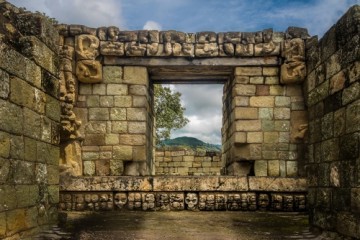When you envision a journey to Central America with a desire to explore historic ruins, your mind likely conjures images of the famous Mayan ruins. While the Maya were indeed one of the most famous ancient civilisations worldwide, it's important not to overlook the fascinating Aztecs. As you embark on an exciting Central America tour, you'll soon learn that Mayan and Aztec ruins, each with their unique history, offer equally awe-inspiring experiences. Read on to discover which Mayan and Aztec sites are considered the best ruins to visit.
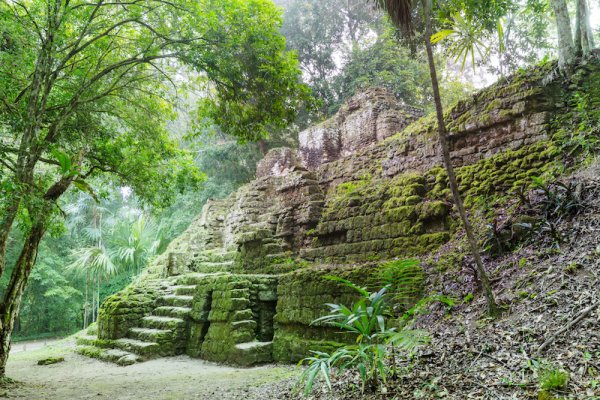
Mayan temples in Tikal National Park
Overview of Mayan Ruins & Civilization
The Maya, preceding the Aztecs, were knowledgeable and had a distinctive scientific inclination. Their deep knowledge of astronomy was instrumental in creating an advanced calendar and precise calculations for predicting significant future events.
As you explore their ruins scattered across Mexico, Belize, Guatemala, and Honduras, you’ll no doubt be privy to the culture’s obsession with time.
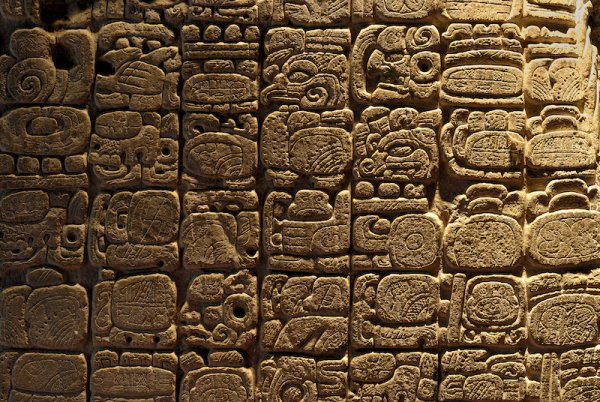
Maya pictograph, Tikal (Guatemala)
> See our Guatemala tours
What Mayan ruins still exist?
Many Mayan ruins are located in Mexico because the civilisation flourished primarily in the southern region of the modern-day country. However, they also left a few remnants of their presence in Guatemala, Belize, Honduras, and even parts of El Salvador.
There are dozens upon dozens of sites still standing, some more excavated than others; most still being unearthed and studied today.
For anyone seeking the best ruins to visit in Central America, southern Mexico offers remarkable variety, from iconic temples to lesser-known treasures.
Keep reading below to discover the most famous sites in the region.
Where are Mayan ruins in Mexico?
While the Maya civilisation’s rule extended far and wide, the epicentre of their existence was the Yucatán Peninsula. Here, you'll find the highest concentration of Mayan ruins, alongside those of ancient civilisations that pre-date them.
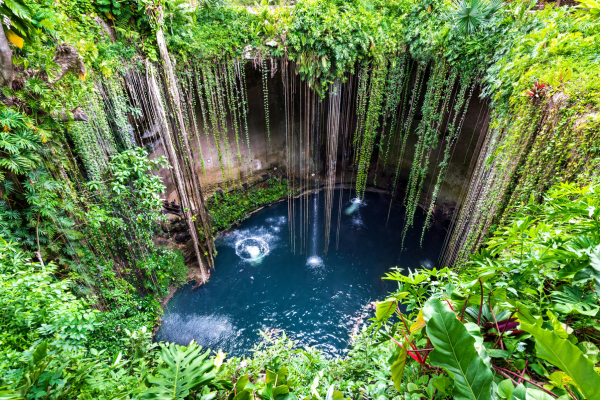
Cenote, archaeological sites and dreamy beaches – these are the calling cards of Mexico’s Yucatan Peninsula
> See our Mexico tours
Overview of Aztec Ruins & Civilization
In contrast to the Maya, the Aztecs had a more warrior-like society, with strong religious and mythological beliefs. They engaged in warfare with neighbouring tribes and had a penchant for human sacrifice. The remnants of Aztec civilisation, visible in the Valley of Mexico, include imposing stone pyramids crowned with temples.
Incidentally, the most prominent collection of Aztec ruins in Mexico is present-day Mexico City. Yes, the whole city. The Aztecs built monumental structures and temples in what was then their capital city, Tenochtitlan, showcasing their advanced architectural and engineering skills.
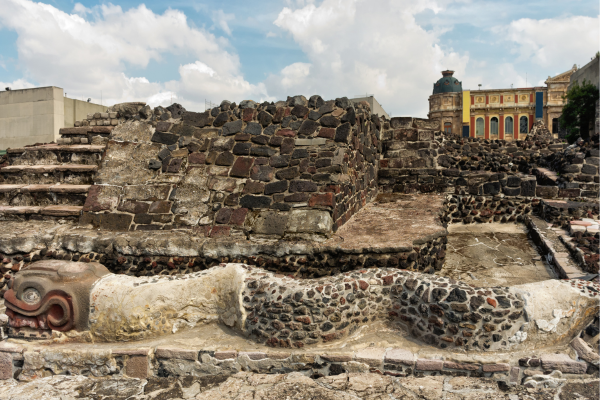
Aztec Ruins of Templo Mayor, in present-day Mexico City
Did you know?
The Mayan civilisation peaked in Mesoamerica from around 250 to 900 AD. The Aztecs emerged later, around the 14th century, and their civilisation flourished until the Spanish conquest in the early 16th century. The Maya predated the Aztecs by roughly 600 to 800 years.
Maya vs Aztec – playing ball through the ages
While distinct in many aspects, the Maya and Aztecs shared intriguing similarities, such as their grand temples and advanced agricultural techniques. However, one captivating facet that stands out is the ancient Mesoamerican ball game commonly known as "Ōllamaliztli" in Nahuatl, the language of the Aztecs.
The game was played with a rubber ball, and its objective was to manoeuvre it into three stone hoops without using hands or feet.
Interestingly, both the Maya and the Aztecs incorporated this sport into their religious practices. In the case of the Aztecs, it has been suggested (though not definitively proven) that, in some specific cases like ceremonial games, the losing team's captain might be chosen for a sacrificial ritual. If that's not an incentive to win, what is?!
Read more about the so-called ancient 'death ball' game.
> Discover Uxmal and so much more on our Signature Mexico in Depth Tour
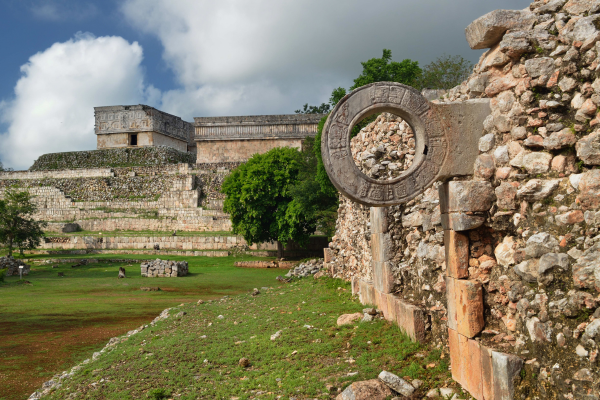
Courtyard for ball games in the ancient city of Uxmal, Mexico
Did you know?
Ōllamaliztli, known as Ulama in Spanish, is still being played in some areas of Mexico today – which makes it the longest continuously played game (and oldest ball game) in history.
The Best Archaeological Sites to Visit in Central America
Rich in history and adorned with remnants of once-mighty cultures, the best archaeological sites in Central America offer a captivating glimpse into the past. Each location tells a unique story of the people who shaped the landscapes we explore today. And if you think that Mayan ruins and Aztec ruins are all there is… you might be pleasantly surprised.
So, let’s start with one which wasn’t built by either!
1. Teotihuacan, Mexico City (MESOAMERICAN)
It’s interesting to know that one of the region’s most prominent ancient sites, Teotihuacan, was built by neither the Maya nor the Aztecs. The city was established sometime between the 1st and 7th centuries AD by an ancient Mesoamerican civilisation whose identity is still unknown. Its builders were likely a multi-ethnic population from the region, given Teotihuacan emerged as a cosmopolitan city with diverse influences.
The site's original name is likewise a mystery. The Aztecs, who arrived in the area centuries after the decline of Teotihuacan, gave it its current name, which in their native language means "the place where the gods were created."
Teotihuacan features several impressive pyramids, including the Pyramid of the Sun, the Pyramid of the Moon, and the Temple of the Feathered Serpent. The Pyramid of the Sun is the largest of the three, rising over 60 metres above ground, and is believed to have been built in several stages between 100 and 250 AD.
> See our tours to Teotihuacan
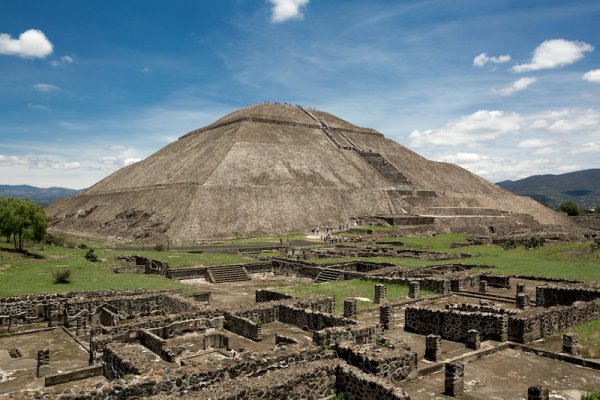
Teotihuacan, Mexico
Did you know?
One of the most exciting activities you can enjoy in Mexico City is a hot air balloon ride over Teotihuacan. This unique experience allows you to soak up splendid views of the ancient city from a different perspective and appreciate its impressive scale and beauty.
2. Tikal, Guatemala (MAYAN)
Nestled within the lush rainforests of Guatemala, Tikal stands as a testament to the grandeur of the ancient Mayan civilisation. If you're looking for an off-beat archaeological site to visit in Central America, this is arguably the one you shouldn't miss.
Flourishing during the Classic Period (200-900 AD), Tikal was a colossal metropolis and one of the largest city-states in the Maya world, covering 16 square kilometres. Its iconic pyramids and temples, notably Temple IV, soaring to about 70 meters, emerge through the jungle canopy.
Recognised for its cultural significance, Tikal has been a UNESCO World Heritage Site since 1979.
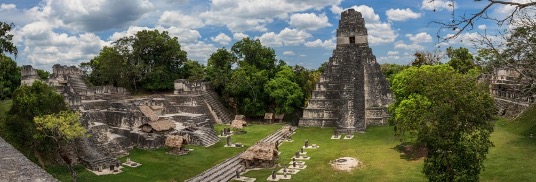
Tikal, Guatemala
3. Chichen Itza, Mexico (MAYAN)
As mentioned above, Mexico's Yucatan Peninsula is a treasure trove of outstanding archaeological sites. Among the many gems stands Chichen Itza, one of the Maya’s most significant political and economic centres, built between 600 and 1200 AD.
Attracting millions of visitors yearly, Chichen Itza is a little commercialised, even hosting a nightly light and sound show, where the ancient structures are illuminated, and narrations recount the history and legends. Yes, it's a bit kitsch but also unique. Given the site's illustrious prominence, however, all is forgiven. This is the single most visited archaeological site in Mexico, after all.
A visit is still an unmissable highlight on the peninsula, especially if you need a break from the (admittedly addictive) beaches of Cancun.
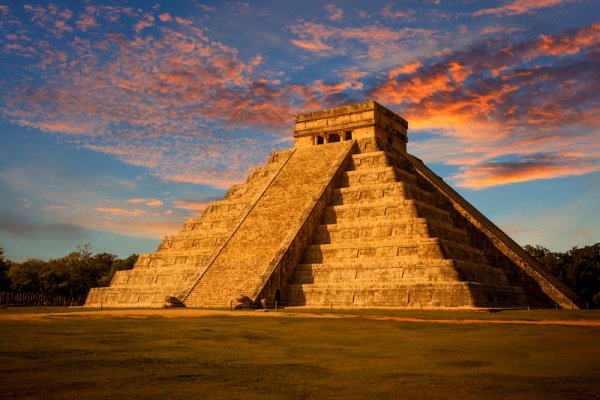
The highlight of Chichen Itza is the Mesoamerican step pyramid known as El Castillo or the Temple of Kukulcan.
> See our tours to Chichen Itza
4. Uxmal, Mexico (MAYAN)
Yet another highlight to discover in the Yucatán Peninsula, Uxmal is best known for its unique mosaic-like patterns, a defining feature of the Puuc architectural style that was popular in the region at the time of the city’s construction.
The Puuc region, in general, was known for its well-planned urban centres – Uxmal being one of the most prominent – and a network of interconnected cities. The population of Uxmal, and all major Mayan cities, would have been quite transient, depending heavily on factors such as agricultural productivity, trade, and the city's political stability.
A guided tour is a must to understand the incredible details that went into the city's construction.
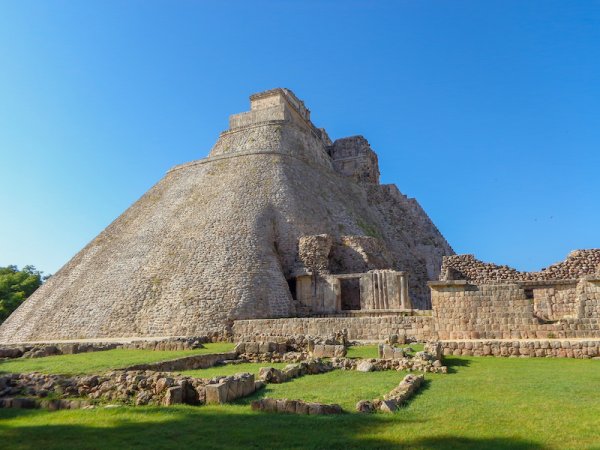
In its heyday, Uxmal was connected via ancient Mayan roads to Chichen Itza, Tikal, and Caracol in Belize
5. Tulum, Mexico (MAYAN)
If you're looking to dive right into the heart of the ancient Mayan empire and enjoy a side serve of sensational Caribbean Sea views, then Tulum is where you'll want to head. It's as if the Mayans finally realised that location and killer views would elevate the value of their city.
In reality, the Mayans were much more pragmatic. Tulum served as a vital seaport for trade and played a strategic role in the Maya's extensive maritime network.
Abandoned to the elements by the time the Spanish arrived, Tulum became a forgotten relic, concealed by the lush jungle until its rediscovery in the 20th century.
The ruins are easily accessible from Cancun and Playa del Carmen, making it a convenient and worthwhile day trip for those staying in the area. Be at the gate right on opening time (8 am) to avoid the midday crowds and scorching heat.
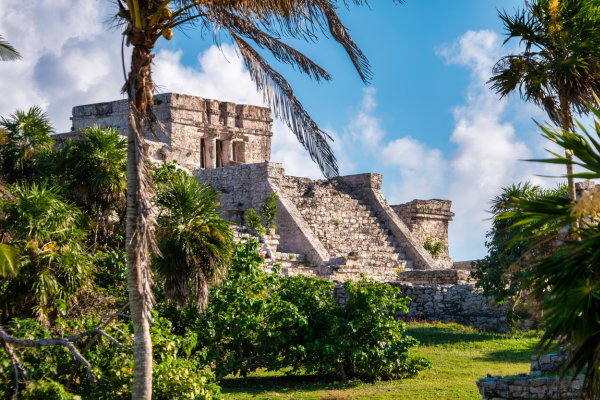
Hidden by lush jungle and framed by impossibly white sandy beaches – Tulum is the second-most visited archaeological site in Mexico, after Chichen Itza
6. Palenque, Mexico (MAYAN)
Chiapas is one of Mexico's most alluring regions, offering an array of natural, historical and cultural highlights. Among the many enticements is Palenque, yet another once-prominent metropolis dating back to 250-900 AD, which is wonderfully preserved.
Some of the most notable structures at Palenque include the Temple of the Inscriptions, which contains the tomb of an important Mayan ruler; the Palace, with its complex system of corridors and rooms; and the Temple of the Cross, known for its detailed stucco reliefs. The ruins are so well preserved here that archaeologists, for the first time, could build a (semi) accurate timeline of the city's Mayan rulers.
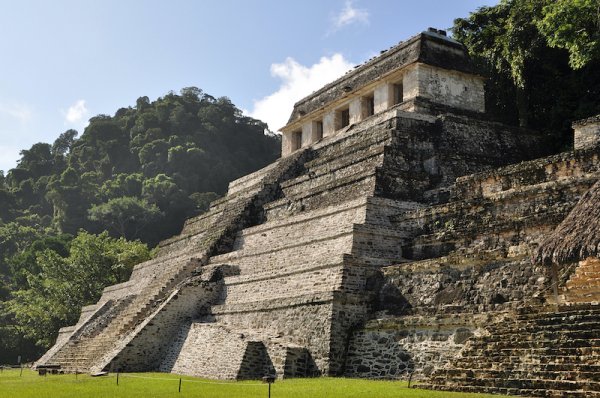
Palenque, Mexico
> See our Discover Chiapas Tour
Any Aztec ruins in Mexico, you ask?
Well, yes, there are. Mind you, a few pivotal differences in the relative urban construction mean that, today, the perception is that there are infinitely more Mayan ruins than Aztec ruins. Because there are!
The Maya used limestone to build their impressive cities, while the Aztecs built theirs of adobe and volcanic rock, which are much less durable. Perhaps more importantly, the Maya covered a much larger geographical area than the Aztecs, heading off into what are now independent neighbouring countries – consequentially building more cities than the Aztecs ever did.
And, for the final nail in the Aztec coffin, came the Spanish colonisers, who settled in the Valley of Mexico and proceeded to dismantle and destroy Aztec cities and structures.
Today, most Aztec ‘treasures’ are housed in Mexico City’s National Anthropology Museum – a beacon of archaeological insight if ever there was one.
Covering over 20 acres, the museum – one of the best of its kind in the world – hosts the most extensive collection of archaeological finds in Mexico. This should be your first stop if you want to learn more about Mayan and Aztec ruins and cultures. Be warned, the museum is colossal – plan an extra day in Mexico City specifically to visit.
Right, next up…
7. Aztec Sun Stone, National Anthropology Museum, Mexico City (AZTEC)
The Aztec Sun Stone, carved around 1479 CE, is commonly known as the Aztec calendar, although everything about its intricate carving reveals much more about the civilisation's celestial beliefs. The enormous basalt sculpture weighs over 20 tons, measures 3.6 meters in diameter, and depicts Aztec ideas on cosmology and time. The central motif features Tonatiuh, the sun god, representing the current era, the fifth sun.
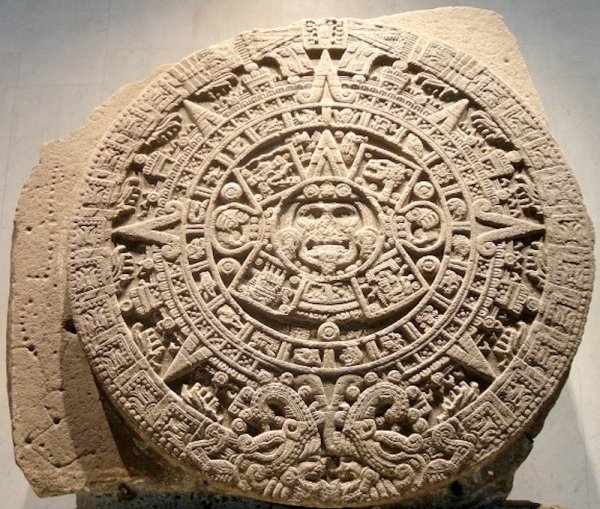
Experts aren't exactly sure how the stone was used, but it was likely a symbolic icon used in prominent ceremonies
Did you know?
The spectacular Aztec Sun Stone was buried by Spanish conquistadores soon after they arrived in modern-day Mexico City and was only rediscovered during repair work to the Cathedral in 1790.
Read more: Top 10 Must-Sees in Mexico City
At Viva Expeditions, we love to plan bespoke itineraries that include more of what you love and less of what you don’t. Craving an archaeological ruin marathon or just want to include a couple of the most famous sites in your itinerary?
Our Destination Specialists are here to help. Contact us today and let us help you plan the Central American trip of a lifetime.
See our complete collection of Central America Tours
Laura Pattara
Laura Pattara writes for Viva Expeditions with a special love for all things Latin America. She had guided overland tours across the continent, reached Machu Picchu five times on foot, and even dressed up as a giant toucan for Carnaval. With a degree in languages and two decades of global travel experience behind her, Laura has a long-standing love for the Andes, soaring condors, and a truly delicious empanada.
|













